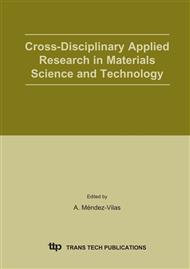p.237
p.243
p.251
p.257
p.269
p.273
p.281
p.287
p.293
Frequency Dependence of Electrical Conductivity and Loss Tangent in Studies on Water-Solution of Irradiated Bones
Abstract:
Bovine bone which has been irradiated with the dose bigger than 10 kGy dissolves in water after having been powdered. Bone has been irradiated with the doses of 10, 25, 50, 100, 500, 750 and finally 1000 kGy. The electrical conductivity of solution was measured at the frequency range of 0.1-1 MHz. For the dose range of 10-100 kGy the electrical conductivity and the loss tangent, in the limits of the measurement errors, were dose independent. For the doses higher than 100 kGy both electrical conductivity and loss tangent revealed higher values then for the dose range of 10-100 kGy. Moreover, the relaxation time of the dissolved molecules was assessed as longer than 10-5s.
Info:
Periodical:
Pages:
269-272
Citation:
Online since:
March 2005
Authors:
Keywords:
Price:
Сopyright:
© 2005 Trans Tech Publications Ltd. All Rights Reserved
Share:
Citation:


